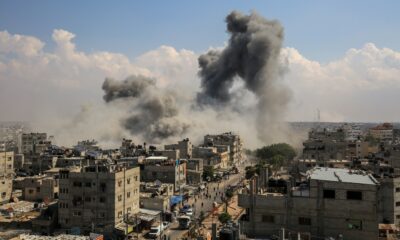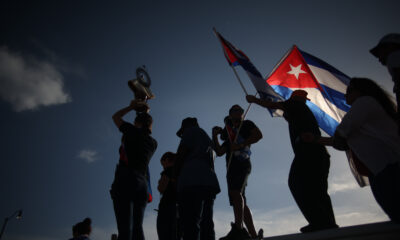US Airstrike KILLS DOZENS – Why?

Dozens of African migrants were reportedly killed in a U.S. airstrike on a Houthi-run detention center in Yemen, raising questions about America’s military involvement in the region and its efforts to mitigate civilian casualties.
At a Glance
- At least 68 African migrants were reportedly killed and 47 injured in a U.S. airstrike on a Houthi-run detention center in Saada, Yemen
- The attack occurred in a Houthi stronghold, with ongoing rescue efforts amid significant destruction
- The U.S. military has conducted over 800 strikes in Yemen since March 15 as part of Operation Rough Rider, ordered by President Trump
- U.S. Central Command claims operations are intelligence-led to minimize civilian casualties but has not commented on this specific incident
- The Houthis began attacking international shipping in the Red Sea in November 2023, prompting U.S. military intervention
Reported Attack on Migrant Detention Center
The Houthi group in Yemen has claimed that a U.S. airstrike hit a detention center in Saada province, killing at least 68 African migrants and injuring 47 others. According to Houthi sources, 35 bodies were recovered from the site, with rescue efforts continuing amid severe destruction. The Houthi-run Interior Ministry stated that 115 migrants were being held at the facility at the time of the attack. Over 50 injured individuals were reportedly transferred to the Republican Hospital Authority, with many in critical condition.
The International Organization for Migration expressed concern over the incident while emphasizing the vulnerability of migrants in the region. Footage of the aftermath was broadcast by Houthi-controlled media, though the authenticity could not be independently verified. This location has seen similar deadly incidents before – a Saudi-led coalition strike on the same compound in 2022 reportedly killed 66 detainees and wounded 113 others.
U.S. Military Operations in Yemen
The reported strike comes amid intensified U.S. military action in Yemen through Operation Rough Rider, which began on March 15 under orders from President Donald Trump. The U.S. has conducted over 800 strikes on Houthi-controlled areas, targeting fighters, leaders, and infrastructure. These operations are launched primarily from the aircraft carriers USS Harry S. Truman and USS Carl Vinson. The campaign aims to counter Houthi attacks on international shipping through the vital Red Sea corridor and Gulf of Aden.
“Since March 15, U.S. Central Command (USCENTCOM) forces have conducted an intense and sustained campaign targeting the Houthi terrorist organization in Yemen to restore freedom of navigation and American deterrence.”, said the U.S. Central Command.
While the U.S. military has not directly addressed the detention center incident, Central Command has previously stated it uses intelligence-led operations to minimize civilian casualties. Another controversial U.S. strike on the Ras Isa fuel port earlier in the campaign reportedly killed at least 74 people. The military justified targeting fuel facilities as an effort to disrupt Houthi operations and revenue sources used to fund attacks on shipping.
Regional Context and Migrant Vulnerability
The Houthis began targeting international shipping in the Red Sea and Gulf of Aden in November 2023, claiming these actions were in support of Palestinians in Gaza. In response, the U.S. established Operation Prosperity Guardian, a maritime security mission aimed at protecting commercial vessels traversing these critical waterways. On March 4, 2025, the U.S. State Department designated Ansar Allah (the Houthis) as a terrorist organization, citing attacks on commercial vessels and U.S. service members.
Migrants from Eritrea, Ethiopia, and other African nations frequently travel through Yemen in hopes of reaching Saudi Arabia for employment opportunities. According to the International Organization of Migration, nearly 60,900 migrants have arrived in Yemen in 2024 alone. These individuals face significant risks, including detention, abuse, and exploitation by various groups throughout their journey. The State Department has reported that the Houthi insurgency hampers efforts to combat human trafficking and child soldier recruitment in Yemen.
Military Strategy and Civilian Impact
U.S. Central Command has emphasized its operational approach is deliberate but has limited disclosure of specific details. The military claims its campaign has significantly degraded Houthi capabilities, targeting weapon systems, storage facilities, and launch sites. The Houthis, who are reportedly supplied with drones by Iran, have used these weapons to target shipping in the Red Sea and Bab el-Mandab Strait, disrupting global commerce through one of the world’s busiest shipping lanes.
Beyond the reported detention center incident, the Houthis claim U.S. airstrikes have hit residential areas in Sana’a, resulting in eight civilian deaths and multiple injuries. Houthi Deputy Prime Minister Mohammed Miftah has threatened retaliation against the United States for the attacks. Information flow from Yemen remains restricted, with the Houthis controlling media access and reportedly ordering the surrender of Starlink satellite internet receivers to maintain their grip on communications.
























